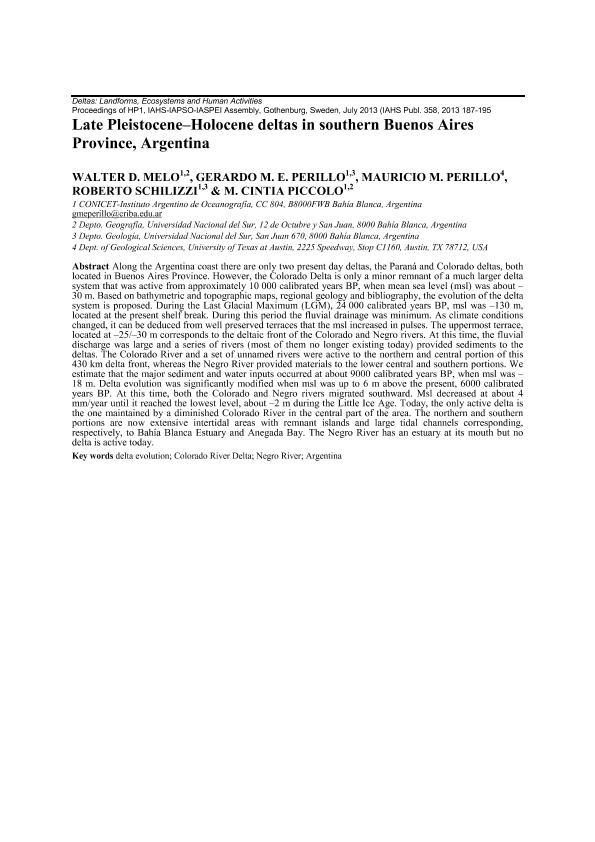Artículo
Late Pleistocene - Holocene deltas in the southern Buenos Aires Province, Argentina
Melo, Walter Daniel ; Perillo, Gerardo Miguel E.
; Perillo, Gerardo Miguel E. ; Perillo, Mauricio Miguel; Schilizzi, Roberto; Piccolo, Maria Cintia
; Perillo, Mauricio Miguel; Schilizzi, Roberto; Piccolo, Maria Cintia
 ; Perillo, Gerardo Miguel E.
; Perillo, Gerardo Miguel E. ; Perillo, Mauricio Miguel; Schilizzi, Roberto; Piccolo, Maria Cintia
; Perillo, Mauricio Miguel; Schilizzi, Roberto; Piccolo, Maria Cintia
Fecha de publicación:
06/2013
Editorial:
IAHS
Revista:
Deltas: Landforms, Ecosystems and Human Activities
ISSN:
0144-7815
Idioma:
Inglés
Tipo de recurso:
Artículo publicado
Clasificación temática:
Resumen
Along the Argentina coast there are only two present day deltas, the Paraná and Colorado deltas, both located on the Buenos Aires Province. However, the Colorado Delta is only a minor remnant of a much larger delta system that was active from approximately 10000 calibrated years BP, when mean sea level (msl) was about -30 m. Based on bathymetric and topographic maps, regional geology and bibliography, the evolution of the delta system is proposed. During the Last Glacial Maximum (LGM), 24,000 calibrated years BP, msl was -130 m, located at the present shelf break. During this period the fluvial drainage was minimum. As climate conditions changed, it can be deduced from well preserved terraces, that the msl increased in pulses. The uppermost terrace, located at -25/-30 m corresponds to deltaic front of the Colorado and Negro rivers. At this time, the fluvial discharge was large and a series of rivers (most of them no longer existing today) provided sediments to the deltas. The Colorado River and a set of unnamed rivers were active to the northern and central portion of this 430 km delta front, whereas the Negro River provided materials to the lower central and southern portions. We estimate that the major sediment and water inputs occurred at about 9,000 calibrated years BP, when msl was -18 m. Delta evolution was significantly modified when msl was up to 6 m above present 6,000 calibrated years BP. At this time, both the Colorado and Negro rivers migrated southward. Msl decreased at about 4 mm/yr until it reached the lowest level, about -2 m during the Little Ice Age. Today, the only active delta is the one maintained by a diminished Colorado River in the central part of the area. The northern and southern portions are now extensive intertidal areas with remnant islands and large tidal channels corresponding,respectively, to Bahía Blanca Estuary and Anegada Bay. The Negro River has an estuary at its mouth but no delta is active today.
Palabras clave:
Delta Evolution
,
Colorado River Delta
,
Negro River
,
Argentina
Archivos asociados
Licencia
Identificadores
Colecciones
Articulos(CCT - BAHIA BLANCA)
Articulos de CTRO.CIENTIFICO TECNOL.CONICET - BAHIA BLANCA
Articulos de CTRO.CIENTIFICO TECNOL.CONICET - BAHIA BLANCA
Articulos(IADO)
Articulos de INST.ARG.DE OCEANOGRAFIA (I)
Articulos de INST.ARG.DE OCEANOGRAFIA (I)
Citación
Melo, Walter Daniel; Perillo, Gerardo Miguel E.; Perillo, Mauricio Miguel; Schilizzi, Roberto; Piccolo, Maria Cintia; Late Pleistocene - Holocene deltas in the southern Buenos Aires Province, Argentina; IAHS; Deltas: Landforms, Ecosystems and Human Activities; 358; 6-2013; 187-195
Compartir



